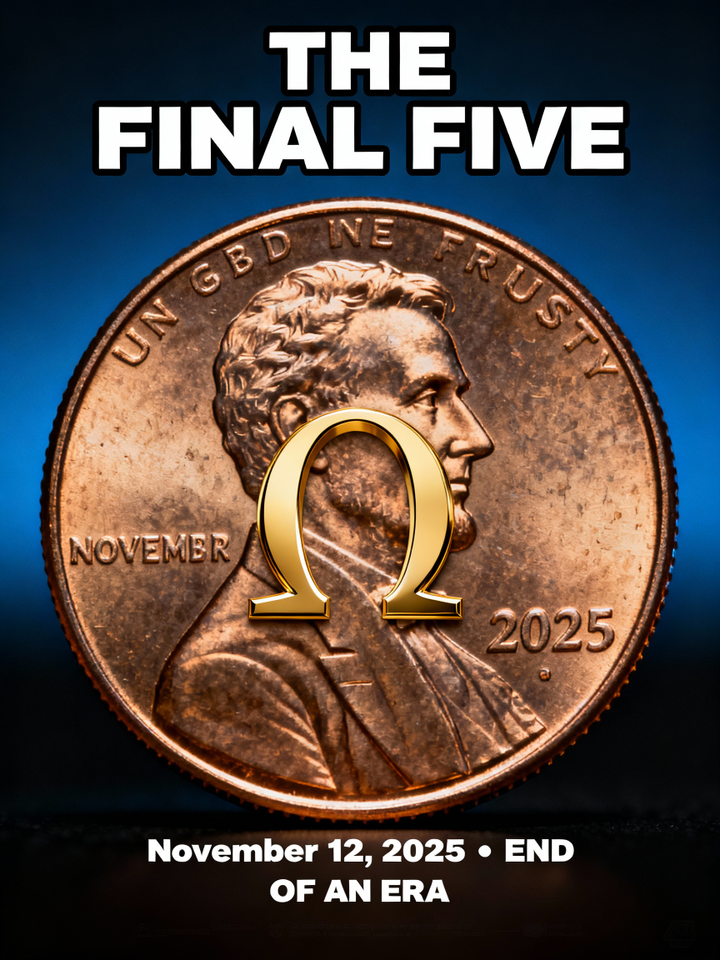The Final Five: Inside the Last U.S. Pennies Ever Minted (And Why They Could Be Worth Millions)
November 12, 2025, marks the end of an era that began in 1792.
On a crisp autumn morning in Washington D.C., Treasury Secretary Scott Bessent struck the final five pennies in U.S. history. With each press of the mint's machinery, a piece of American heritage came to a symbolic close—232 years of the humble one-cent coin.
These aren't just any pennies. Each of the final five bears a rare omega symbol (Ω), marking them as the absolute last pennies the U.S. Mint will ever produce for circulation. Numismatic experts are already predicting these historic coins could fetch millions at auction when the Treasury Department puts them up for sale next year.
For collectors, investors, and Americans who've carried pennies in their pockets for generations, November 12, 2025, represents the biggest numismatic event of the year—and perhaps the decade.
The End of America's Most Iconic Coin
The U.S. penny's journey began with the Coinage Act of 1792, which established the first federal mint and authorized production of the one-cent piece. For more than two centuries, the penny has been a constant in American life—funding childhood candy purchases, filling wishing wells, and teaching generations about the value of saving.
But rising production costs, inflation, and changing consumer habits have finally caught up with Abraham Lincoln's profile on copper-plated zinc. The coin that once represented meaningful purchasing power now costs taxpayers nearly four cents to manufacture—more than quadruple its face value.
The last U.S. coin denomination to be discontinued was the half-cent way back in 1857. At that time, the half-cent had more purchasing power than today's dime. Now, 168 years later, the penny follows its predecessor into the history books.
The Economic Case That Killed the Penny
President Trump's February 2025 announcement was characteristically blunt: "For far too long, the United States has minted pennies which literally cost us more than 2 cents. This is so wasteful!"
The numbers backed him up. According to U.S. Mint data, producing a single penny cost approximately 3.6 cents in 2024—a figure that had been rising steadily due to increased metal and labor costs. With billions of pennies minted annually, this inefficiency was draining $56 million from taxpayers every year.
The production economics were brutal:
-
Raw materials: Zinc and copper prices had surged
-
Labor costs: Minting requires specialized workers and equipment
-
Distribution: Transporting heavy coins to banks nationwide
-
Replacement rate: Pennies get lost, discarded, or hoarded faster than other denominations
Congress had debated eliminating the penny for decades, but it took overwhelming bipartisan support—and the fiscal reality of negative return on investment—to finally pull the trigger.
Production actually ceased in June 2025, though the official announcement came months later. The November 12 ceremony was largely symbolic, but it allowed Treasury Secretary Bessent to create the "Final Five" omega-marked pennies that will soon become the most valuable one-cent pieces in history.
What Makes the Omega Pennies Priceless
The omega symbol (Ω), representing "the end" in Greek, was hand-struck onto each of the final five pennies during the ceremonial minting. This unprecedented mark makes them instantly identifiable and absolutely unique in U.S. coinage history.
Collectors are comparing these coins to other famous "last" items that have fetched astronomical prices:
-
The final Concorde flight tickets sold for thousands
-
The last Blockbuster Video membership card became a collector's item
-
Final production cars from discontinued models command premium prices
But coins have something those items don't: a 232-year legacy, federal authentication, and a built-in collector market worth billions. When similar historically significant coins have gone to auction—like the 1933 Double Eagle that sold for $18.9 million—it's set records that stand for decades.
The Treasury Department has announced plans to auction the omega pennies sometime in 2026, with proceeds going to debt reduction. Auction houses are already preparing their estimates, with some experts suggesting each penny could bring $2-5 million, depending on bidding intensity.
For perspective: if each of the five sells for $3 million, that's $15 million raised by pennies that cost 18 cents to produce.
The Penny's Visual Evolution: 1857-2025
The American penny has worn many faces throughout its lifetime:
Indian Head Cent (1859-1909): Designed by James Barton Longacre, featuring Lady Liberty in a Native American headdress—a design that would be controversial by today's standards.
Lincoln Cent (1909-present): Introduced for Abraham Lincoln's 100th birthday, making him the first historical figure on U.S. circulating coinage. The reverse featured wheat stalks until 1958.
Memorial Reverse (1959-2008): The Lincoln Memorial replaced wheat stalks to commemorate Lincoln's 150th birthday.
Bicentennial Series (2009): Four different reverse designs honored aspects of Lincoln's life.
Union Shield (2010-2025): The final design, representing Lincoln's preservation of the Union.
Throughout these changes, one thing remained constant: the penny got progressively less valuable while costing more to make.
Following Canada's Lead: A North American Trend
The United States is far from the first nation to eliminate its lowest-denomination coin. Canada discontinued its penny in 2012, and the transition was remarkably smooth.
Countries that have eliminated low-value coins:
-
Canada: Stopped penny production in 2012; rounded cash transactions to the nearest five cents
-
Australia: Eliminated 1- and 2-cent coins in 1992
-
New Zealand: Dropped the 5-cent coin in 2006 (after eliminating smaller denominations earlier)
-
Finland, Netherlands, Belgium: Stopped producing 1- and 2-cent euro coins domestically
-
Sweden, Norway, Denmark: Eliminated their lowest denominations years ago
-
Israel, Brazil, South Africa: All ended low-value coin production
The pattern is clear: as inflation erodes purchasing power and production costs rise, countries worldwide are abandoning coins that cost more to make than they're worth.
Canada's experience is particularly instructive. Initial concerns about "rounding up" hurting consumers proved largely unfounded. Studies showed the rounding actually balanced out—some transactions rounded up, others down, with minimal overall impact on consumer spending.
Life After Pennies: What Changes on November 13
Despite production ending, pennies aren't disappearing overnight. The U.S. Mint estimates that pennies already in circulation will remain in use for approximately 30 years before wear and loss naturally phase them out.
Here's what's changing:
Legal Tender Status: Pennies remain valid currency indefinitely. You can still use them for purchases, and businesses must accept them for debt payment.
Cash Rounding: Most retailers will adopt Canadian-style rounding to the nearest nickel for cash transactions. Electronic payments remain unaffected—your credit card will still be charged $10.97, not $11.00.
Collector Versions: The U.S. Mint will continue producing proof pennies and special collector sets, similar to how it still makes half-dollars that rarely circulate.
Banking Changes: Banks will gradually reduce penny inventories, though they'll continue accepting deposits of existing pennies.
Pricing Psychology: Retailers who've long used $9.99 pricing will likely continue the practice, even as cash customers pay $10.00.
The Collector's Perspective: 2025 Pennies Are Gold
For numismatists, the penny's discontinuation creates immediate collecting opportunities—and potential investments.
What to look for right now:
2025-Dated Pennies: Any penny with a 2025 date will become increasingly collectible. Check your change!
Mint Marks Matter: Philadelphia (P) and Denver (D) 2025 pennies should both be saved. Denver typically has higher mintages, making Philadelphia coins potentially more valuable long-term.
Condition Is Everything: Circulated 2025 pennies will be common. Uncirculated, mint-state examples—especially those graded MS-67 or higher—will command premiums.
Proof Sets: 2025 U.S. Mint proof sets containing pennies are already selling above issue price.
Error Coins: Any 2025 penny with minting errors (double dies, off-center strikes, etc.) will be especially desirable.
Roll Collecting: Sealed, bank-wrapped rolls of 2025 pennies from either mint could appreciate significantly.
The omega-marked "Final Five" will obviously be the crown jewels, but don't overlook regular 2025 pennies. When Canada eliminated its penny, late-date Canadian cents immediately increased in collector value. The same will happen with 2025 U.S. pennies.
The Controversy: Not Everyone's Celebrating
While economists and efficiency advocates cheered the penny's demise, not everyone is happy.
Arguments for keeping the penny:
Tradition and Sentiment: The penny has been part of American life for 232 years. Its loss represents the end of cultural touchstones like "a penny for your thoughts" and lucky pennies.
Exact Change: Some consumers prefer paying exact amounts rather than relying on rounding.
Charitable Donations: Penny donation jars at checkout counters raise millions annually for charities.
Zinc Industry: The zinc lobby fought hard to save the penny, as pennies consume significant zinc production.
Arguments for elimination:
Fiscal Waste: Losing $56 million annually to produce money that loses value is indefensible.
Time Cost: Counting pennies wastes time at registers, in banks, and at home.
Environmental Impact: Mining and minting pennies creates unnecessary environmental damage.
Digital Shift: With electronic payments dominating, physical pennies are increasingly irrelevant.
The low-income community concern—that rounding would disproportionately hurt the poor—was studied extensively. Data from Canada and other countries showed this fear was unfounded, as rounding works both ways and electronic payments (unaffected by rounding) are now available even to those without traditional bank accounts.
What Planet Banknote Collectors Need to Know
At Planet Banknote, we specialize in helping collectors acquire historically significant currency. The penny's discontinuation creates a unique moment for numismatists.
Our recommendations:
Act Now: Start acquiring 2025-dated pennies in the highest grades you can afford. Future collectors will want these.
Think Long-Term: While the omega pennies will be auction spectacles, regular 2025 pennies represent accessible investments.
Diversify: The penny joins our extensive collection of discontinued world currencies. Owning "last" coins from multiple countries tells a broader story.
Authenticate: As 2025 penny values rise, counterfeits will emerge. Buy from reputable dealers who guarantee authenticity.
Preserve: Store pennies properly using archival holders, not PVC flips that can damage copper surfaces.
The End of an Era, The Start of a Collection
"Find a penny, pick it up, and all day long you'll have good luck." That old saying takes on new meaning when the penny you're finding is one of the last ever made.
The U.S. penny's discontinuation isn't just about economics or efficiency. It's about the evolution of how we think about money, value, and tradition in a digital age. For 232 years, the penny has been the smallest unit of American currency—and perhaps the most symbolic.
Abraham Lincoln, whose profile has graced the penny since 1909, once said, "Whatever you are, be a good one." The penny may be leaving circulation, but it's doing so at the top—as one of the most collected, most meaningful, and now most historic coins in American numismatics.
Before they're gone from your pocket change forever, check those pennies. You might be holding a piece of history worth far more than one cent.
Ready to start your collection of historic U.S. pennies? Browse Planet Banknote's U.S. coin selection and secure your piece of numismatic history before prices climb. Whether you're seeking 2025-dated specimens or historic Lincoln cents from throughout the 20th century, we offer authenticated coins in various grades to suit every collector's budget.
[Shop U.S. Coins →] Silver & Gold
Explore Popular Articles
More Than Money: The Tangible Assets Drawing a New Crowd
The New Golden Age of Collecting A Market Transformed by Youth, Technology, and Value For decades,...
The Collector's Hierarchy
The Collector’s Hierarchy Understanding Issued, Specimen, and Proof Banknotes In the sophisticated...
The Great Revaluation: Strategic Outlook on Commodities, Equities, and the Return of Tangible Assets (2025–2026)
Executive Summary: The Pivot to Tangible Value The global financial architecture is currently navi...




